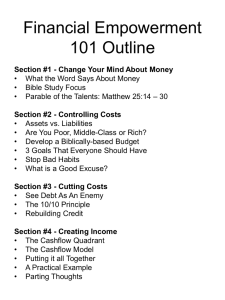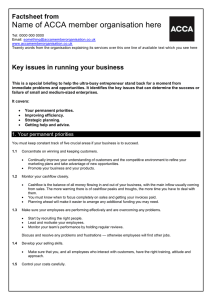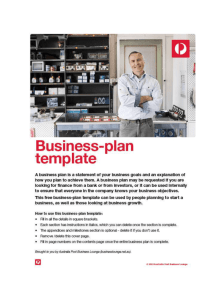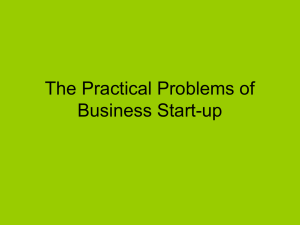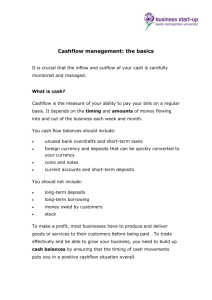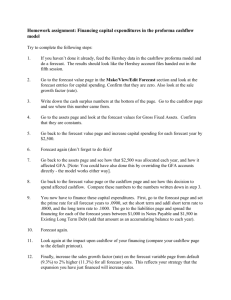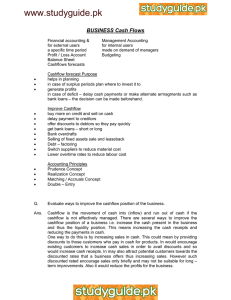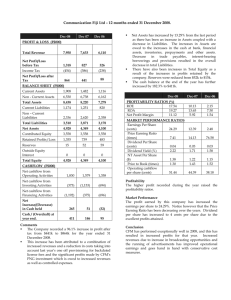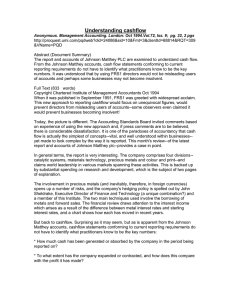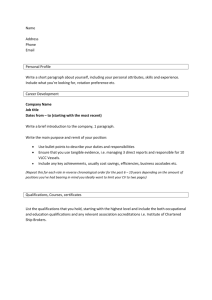Start-up BUSINESS PLAN TEMPLATE
advertisement
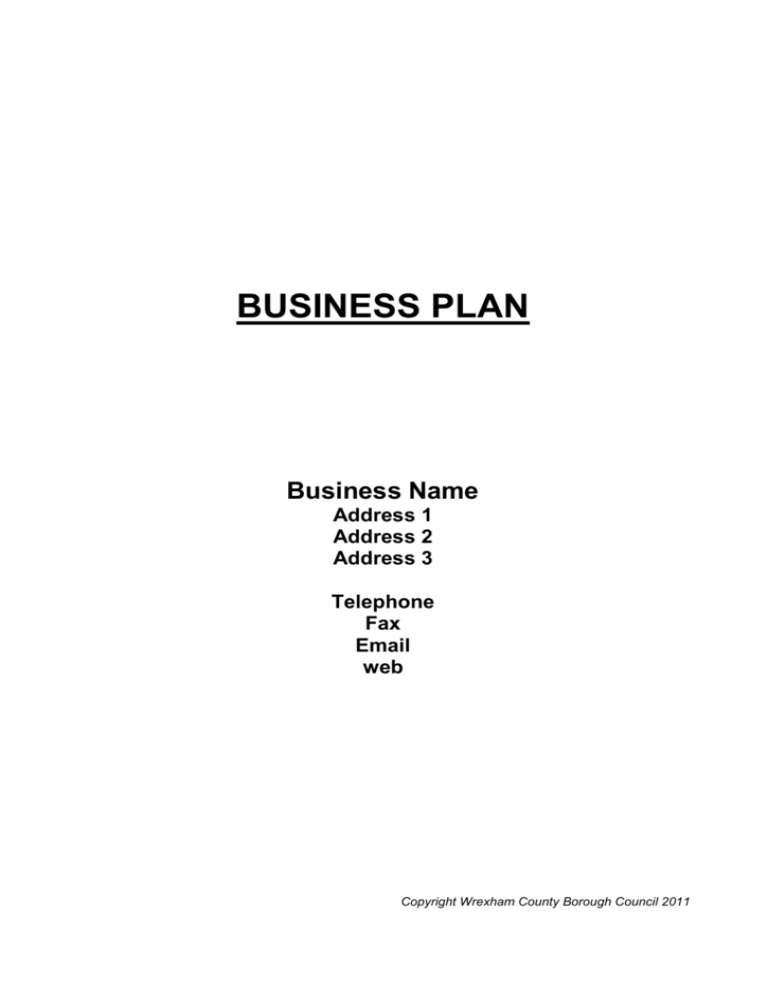
BUSINESS PLAN Business Name Address 1 Address 2 Address 3 Telephone Fax Email web Copyright Wrexham County Borough Council 2011 Index 1. Executive Summary 2. Business Description 3. The Market, Marketing & Promotion 4. People, Qualifications & Experience 5. Operations, Facilities, Insurances & Legal Requirements 6. Start Costs, Funding & Financial Projections 7. Timetable & Action Plan 8. APPENDICES Section 1 Executive Summary This should be completed last and be kept fairly short – not more than 1 page. Ideally it should be a short overview of the whole plan and is a good place to use your personality and enthusiasm for the business. It should explain what the business is, what it will offer (what you are selling), and why it will be successful. Explain the timetable; when do you hope / intend to start? What needs to happen to make sure that your start date is achieved? What key milestones have been set for the business (sales & profit growth, employment, expansion plans & aspirations etc) It could be used as a tool to help you put together a one minute introduction; a short description of yourself and your business and why others should do business with you, so outline the benefits. WRITE THIS LAST USING INFORMATION FROM THE OTHER SECTIONS Section 2 Business Description This section will detail the products, services and facilities to be offered and will include perceived customer benefits which will give your business a competitive edge – your USP. Think about the range of products or services you can supply, and how this can help the customer. Explain what products and / or services you will be selling, and how these differ from other products and services on the market. Include technical details if appropriate or description of the service “experience”. Is it an online or “real world” business – or a mixture of both? What will the pricing structure be? Will there be fixed prices, or a range of prices based on size / volume / time of day / time of year etc. You should also describe how prices will be calculated – e.g. based on an hourly rate, a fixed mark up etc. and whether prices will be published or quoted per job. Describe what the structure of the business will be – sole trader, limited company, partnership, social enterprise etc. What is your vision for the business – are you aiming for self-employed income or growth? If appropriate who will your suppliers be? Do you have an agreement with them? Can you ensure continuity of supply? (NB this refers to key suppliers of raw materials or components). This section will help to focus your mind on what you will realistically be able to achieve within your own premises/financial constraints. Questions: What do you do? What does that mean? Do you offer more than one product or service? What is your “USP”? i.e. what differentiates you from competitors? Will you charge at a standard hourly rate, a standard product rate, or on a per job basis? What is the vision for the business? What are your objectives for the next 1, 3, 5 years? Are you planning an exit strategy? Section 3 The Market, Marketing and Promotion This section will detail the type of customer you intend to target and why. You should try to describe any market research that you have carried out (either direct or indirect) and what you have learned from this. Include some statistical information on the state of your market – is it growing, static, declining? Who is your competition – are you offering exactly the same in a decreasing market or are you offering different things in a growing market? It is important to access whether you are generating “new business” or merely displacing someone else’s trade. If possible list the strengths & weaknesses of your main competitors. You will need to include specific information about your target market (s) and ensure that what you are offering meets the customer’s needs. Who will your customers be? Are you able to describe them and their “needs”. Will you target a local, regional, national or even international market? This affects how and where you will market the business. Details of your strategy and the size of the market you are aiming to capture will assist you when you prepare income expectations for your cashflow. Also methods and costs of sales activity and promotion will need to be included – these also assist in producing your financial information and the cashflow. You could include these in a Marketing Plan. Think about how you will “position” your business in the market. For example, will you offer a “cheap & cheerful” or a high quality, premium priced service? Think about how other businesses do this (e.g. Mark’s & Spencer v Primark or Ryanair v British Airways). It is a good idea to include details of how you present yourself and your business. This is easily done by including business cards, pictures of a sign-written vehicle, etc. You will probably find it helpful to plan your promotional activity for several months ahead. This will enable you to identify potential costs and also give you the opportunity to monitor the success of your activity. Questions: Who are your target customers? Who are your competitors? Where will you fit in? Why will they buy from you? How will you promote the business – advertising, communication, other marketing activity? How much will this cost you? Can you afford it? How will you measure the effectiveness of your marketing? How will you present & position your business? Section 4 People Qualifications & Experience Give details of key people involved in the business – i.e. you, any partners, the management team. What experience, skills and knowledge are available to the business? Include any staff you intend to employ now or in the future (for example if you intend to recruit a mechanic, web designer etc). The C.V.’s and/or achievements of key personnel should be attached as an appendix to the plan. Include details of any relevant skills in your field, interpersonal skills and business skills. This can be useful for identifying skills gaps. Also include any accreditations, qualifications and memberships or professional or trade bodies. (Depending on the size of the business this section would benefit from a simple organisation structure to identify tasks/roles and who is to be responsible for ensuring they are carried out). Do you have access to external advice & support (e.g. banks, advisors etc? Who will you bank with? Are they supportive of your business? Who is your accountant? Does he/she offer business advice?) Questions: About yourself and your partner(s); What relevant skills, qualifications or experience do you have? Do you have any business skills? If not what steps will you take to get advice & support? If you will be employing people; What will they do? Why will they do that? What will they bring to the business? Section 5 Operations, Facilities, Insurances & Legal Requirements This section will provide details of any business premises, licences, regulatory issues, insurances, capital investments (machines, vehicles etc) that you will need to have in place either by law or in order to support the business plan. You should include things like: - Premises & equipment Planning Requirements Fire Safety Requirements Rating Requirements Building Regulations (where alterations are required) Insurances held / required Statutory obligations have been met Rent agreements / contracts held You should provide an overview of what this means for your Start Up costs (i.e. those costs you will incur to start the business, usually before you are able to earn any income) and how these will be funded? (In the next section you will need to provide full details of Start Up Costs). Questions: Will you have an appropriate base? Do I need to acquire premises? What do I need & where will they be? What will your rent & rates be? What are the terms of any leases held? What insurances will you need to have in place? E.g. Public Liability, Product Liability, Employer’s Liability etc) Will you need a licence or need to make any other declarations? What will your set up costs be? Section 6 Start Costs, Funding & Financial Projections This section explains how quickly you expect the business to grow and how you intend to finance this growth. The section will have several sub-sections as follows: - 1 Start-up costs. Use the Start Up Costs template to help you to list all of the costs you expect to incur before you start trading (or sometimes soon after). Examples include IT equipment, vehicles, website, marketing & promotion, stock, tools & equipment, deposits for rent, insurance, qualifications etc. 2 Finance requirements (if applicable). This describes where the money to fund the start up of the business will come FROM. This could include your own savings, bank loans, other loans (e.g. friends & family), grants and credit. 3 12 months’ cashflow (to try to predict bank account). This is an important forecast of your “liquidity”. Use the Cashflow Forecast template to help you to predict cashflows in and out of the business each month for at least the first year. Then monitor ACTUAL cashflow. This will help you to make sure that you have enough money available to cover expenses. Include notes to explain income/expenditure forecasts on the Cashflow 4 Profit and Loss forecasts (minimum 12 months); Profit and loss is not essential for all businesses, although some may want to use it as a financial tool. A monthly P&L forecast looks quite similar to a cashflow forecast but describes transactions rather than movements of cash. Also some items (e.g. drawings, loan repayments) will appear on a cashflow but not on the P&L; while others (e.g. depreciation) appear on the P&L but not on the cashflow forecast. You should also think about your “Break Even point” (how much revenue do you need to cover expenses) (e.g. if gross margin is 25% and fixed expenses are £1000 per month you will need to sell £4000 per month to cover expenses). Questions: What will you need to purchase ready for the business start? How much will they cost? What will be the monthly cashflows in and out of the business? Will you have the funds available to cover times when flows OUT exceed flows IN? If not how will you address any shortfall (e.g. overdraft facility). How much profit do I expect to make in the first year? What is my break even point? What is my break even price? Section 7 Timetable & Action Plan This tells you and any other stakeholder what actions need to be taken to make the Plan work. Use it to provide a checklist of all the activities that need to be undertaken to get the business up and running within the required timescale. Use the Start Up Action Plan Template (and include as part of the Business Plan). Provide details of planned milestones for the business e.g. what will we have achieved after 3/6/9/12 months? Questions: When do you intend to start the business? How will you ensure that this is achieved? What actions are required by you and anybody else? What needs to be done and why? Who needs to do it? When does it need to be done by? What milestones have been set for the business (sales, profit, premises, employment, customers won, accreditations etc) Section 8 Appendices Use appendices to provide more detailed information (i.e. C.V.’s, licenses, planning consent, customer & supplier agreements etc) to support the plan. Questions: What documents have you given details of in the plan? Can you provide evidence of these documents? Will you have marketing literature (cards, flyers, brochures, etc)? If you have referred to a document, you should copy it and include it here.
